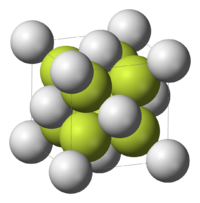Barium fluoride
 |
|
| Identifiers | |
|---|---|
|
7787-32-8 |
|
| 3D model (Jmol) | Interactive image |
| ChemSpider |
56421 |
| ECHA InfoCard | 100.029.189 |
| PubChem | 62670 |
| RTECS number | CQ9100000 |
|
|
|
|
| Properties | |
| BaF2 | |
| Molar mass | 175.34 g/mol |
| Appearance | white cubic crystals |
| Density | 4.893 g/cm3 |
| Melting point | 1,368 °C (2,494 °F; 1,641 K) |
| Boiling point | 2,260 °C (4,100 °F; 2,530 K) |
| 0.16 g/100 mL (20 °C) | |
| Solubility | soluble in methanol, ethanol |
| -51.0·10−6 cm3/mol | |
|
Refractive index (nD)
|
1.455 |
| Structure | |
| Fluorite (cubic), cF12 | |
| Fm3m, No. 225 | |
| Hazards | |
|
EU classification (DSD)
|
Harmful (Xn) |
| R-phrases | R20/22 |
| S-phrases | (S2), S28 |
| NFPA 704 | |
| Flash point | Non-flammable |
| Lethal dose or concentration (LD, LC): | |
|
LD50 (median dose)
|
250 mg/kg, oral (rat) |
| Related compounds | |
|
Other anions
|
Barium chloride Barium bromide Barium iodide |
|
Other cations
|
Beryllium fluoride Magnesium fluoride Calcium fluoride Strontium fluoride |
|
Except where otherwise noted, data are given for materials in their standard state (at 25 °C [77 °F], 100 kPa).
|
|
|
|
|
| Infobox references | |
Barium fluoride (BaF2) is a chemical compound of barium and fluorine and is a salt. It is a solid which can be a transparent crystal. It occurs in nature as the mineral frankdicksonite.
The solid adopts the fluorite structure and at high pressure the PbCl2 structure. In the vapor phase the BaF2 molecule is non-linear with an F-Ba-F angle of approximately 108°. This is an exception to VSEPR theory which would predict a linear structure. Ab initio calculations have been cited to propose that contributions from d orbitals in the shell below the valence shell are responsible. Another proposal is that polarisation of the electron core of the barium atom creates an approximately tetrahedral distribution of charge that interacts with the Ba-F bonds.
Barium fluoride is transparent from the ultraviolet to the infrared, from 150–200 nm to 11–11.5 µm, and can be used as a material to make optical components such as lenses. It is used in windows for infrared spectroscopy, in particular in the field of fuel oil analysis. Its transmittance at 200 nm is relatively low (0.60), but at 500 nm it goes up to 0.96–0.97 and stays at that level until 9 µm, then it starts falling off (0.85 for 10 µm and 0.42 for 12 µm). The refractive index is about 1.46 from 700 nm to 5 µm.
Barium fluoride is also a common, very fast (one of the fastest) scintillators for the detection of X-rays, gamma rays or other high energy particles. One of its applications is the detection of 511 keV gamma photons in positron emission tomography. It responds also to alpha and beta particles, but, unlike most scintillators, it does not glow in ultraviolet light. It can be also used for detection of high-energy (10–150 MeV) neutrons, and use pulse shape discrimination techniques to separate them from simultaneously occurring gamma photons.
...
Wikipedia

